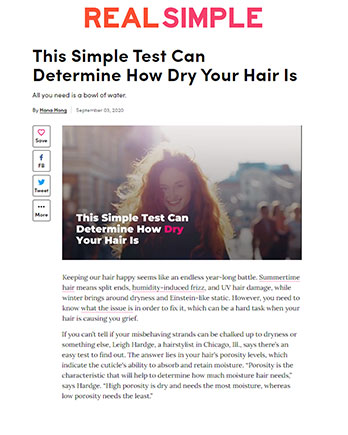Real Simple September 3, 2020
 Real Simple.com
Real Simple.com
Hair
This Simple Test Can Determine How Dry Your Hair Is
All you need is a bowl of water.
Keeping our hair happy seems like an endless year-long battle. Summertime hair means split ends, humidity-induced frizz, and UV hair damage, while winter brings around dryness and Einstein-like static. However, you need to know what the issue is in order to fix it, which can be a hard task when your hair is causing you grief.
If you can’t tell if your misbehaving strands can be chalked up to dryness or something else, Leigh Hardges, a hairstylist in Chicago, Ill., says there’s an easy test to find out. The answer lies in your hair’s porosity levels, which indicate the cuticle's ability to absorb and retain moisture. “Porosity is the characteristic that will help to determine how much moisture hair needs,” says Hardge. “High porosity is dry and needs the most moisture, whereas low porosity needs the least.”
The Float Test for Hair Porosity
Luckily, you don't need to be a trichologist or have fancy tech materials to measure your hair’s porosity—a simple water test will do. First, shampoo and rinse hair to remove any product buildup. Once your hair is dry and clean, pluck out a precious strand (don’t worry, it will grow back) and drop it in a bowl filled with water.
After letting it set for two to four minutes, watch the strand to see if it sinks to the bottom of the bowl or floats at the top.
Low porosity hair will stay on top of the water
Medium porosity hair will float and stay suspended in the middle
High porosity hair will sink to the bottom of the bowl
After determining your hair's porosity, you can best determine the right product and treatment your hair needs to keep it hydrated and healthy.
Low Porosity
Hair with low porosity has a tightly bound cuticle layer with overlapping scales that lay flat. This type of hair repels moisture when you try to wet it, which also means it’s prone to build-up from deep conditioning products, making it feel stiff and straw-like. Choose lighter, liquid-based products like hair milks that won't sit on your hair and leave it oily or greasy.
Medium Porosity
If you have medium porosity hair, it means your cuticle layer is a little looser, allowing just the right amount of moisture to enter while preventing too much from escaping. Although hair with normal porosity tends to hold styles and colors well, be careful not to perm or color your hair too much as it can increase its porosity over time. Use occasional deep conditioning treatments with protein conditioners to maintain its hydration levels.
High Porosity
If you have high porosity hair, it means your hair loses moisture easily. Your cuticle is damaged and has gaps in the cuticle, letting too much moisture into your hair and leaving it prone to frizz. Restoring hydration is a must, so layer leave-in conditioners, hair oils, sealers, and hair butters to help fill the gaps in your damaged cuticles and help it hold on to the moisture you're giving it.
“There are many misconceptions that can be made by visually judging hair, especially with black, bi-racial and POC hair, which can come in a variety of types and textures,” says Hardge. Although you’ll have to find the best hair products that are right for your hair type, the good news is, the water test is completely universal and works for all hair types, making it a great place to start.
